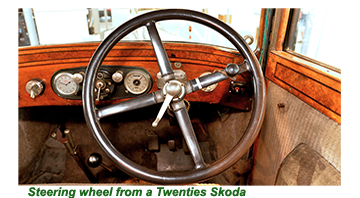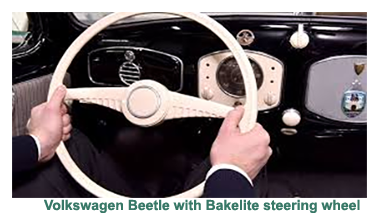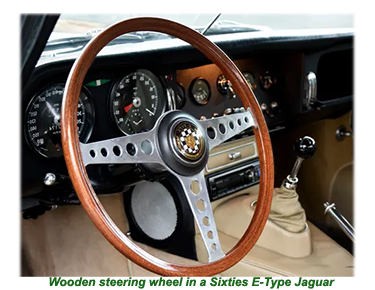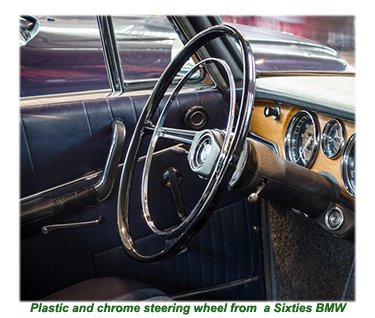 When internal combustion-engined cars began to hit the roads more than one hundred and fifty years ago, the steering wheels we have become so familiar with today were nowhere to be seen.
When internal combustion-engined cars began to hit the roads more than one hundred and fifty years ago, the steering wheels we have become so familiar with today were nowhere to be seen.
All kinds of devices were used to steer these early vehicles, which, at least from appearance, must have been a challenge to operate.
 It was only during the early years of the 20th century did conventional steering wheels began to be fitted on passenger cars and have remained much the same ever since.
It was only during the early years of the 20th century did conventional steering wheels began to be fitted on passenger cars and have remained much the same ever since.
 The earliest steering wheels fitted were based on a metal frame covered with solid wood. As the years went by, aluminium replaced solid metal, and solid wood was replaced by pre-formed plywood coated by a thick veneer layer- usually to match the rest of the vehicle's interior trim.
The earliest steering wheels fitted were based on a metal frame covered with solid wood. As the years went by, aluminium replaced solid metal, and solid wood was replaced by pre-formed plywood coated by a thick veneer layer- usually to match the rest of the vehicle's interior trim.
In the post-war years, most steering wheels were produced using synthetic materials, thermoplastics or Bakelite.
 Bakelite, regarded historically as the first plastic, is the registered trademark of its Belgian inventor, Leo Hendrik Baekeland.
Bakelite, regarded historically as the first plastic, is the registered trademark of its Belgian inventor, Leo Hendrik Baekeland.
>Baekeland mastered the process of compressing phenol resin under high pressure till it formed a rock-hard compound.
Thermosetting plastics such as Bakelite are characterised by their outstanding electrical insulation capability and the ease with which they can be shaped, making them a favourite of car manufacturers in the US and Europe.
Irrespective of which format it was produced in, the first step that the restorer has to take when refurbishing their classic car's steering wheel is to remove it from the vehicle to be worked on.
Dismounting the steering wheel is a straightforward process, requiring little physical effort and the correct tools.
![]()
 The first step is to disconnect the vehicle's battery, thus immobilising any electric devices that might be connected to it.
The first step is to disconnect the vehicle's battery, thus immobilising any electric devices that might be connected to it.
The next stage is to remove the horn ring and mounting nut holding the steering wheel in place, using the appropriate socket to loosen the mounting nut beneath.
Horn rings on older vehicles are often spring-loaded, meaning that the ring should be turned slowly and gingerly, reducing the danger of it suddenly springing off.
The final stage of the dismantling process needs a special tool known as a wheel puller that should be carefully fitted onto the centre of the steering wheel, first ensuring that it is centred perfectly before removing it, thus ensuring that the wheel will be in the correct position after refurbishment.
 Once the wheel has been removed, the restoration process can get underway.
Once the wheel has been removed, the restoration process can get underway.
The first step in restoring a wooden steering wheel is to remove what remains of the veneered outer cover, which can be rapidly dealt with using a saw blade, a hammer and a chisel.
Great care should be taken not to damage the aluminium base, especially the areas that will be exposed.
Once the aluminium core has been entirely exposed, it should be cleaned with fine wool, with particular attention paid to the parts that may have become oxidised.
If the areas oxidised do not respond to the steel wheel treatment, there may be no option to send the wheel off for a dose of glass bead blasting and grinding.
![]()
To be on the safe side, the restorer should cover the steering wheel's spokes with adhesive tape where they meet the rim and pass a grinding wheel over the rest of the surface to allow the plywood/veneer surface to be applied to grip the metal easily.
Rebuilding the wooden parts of a steering wheel is no easy task, requiring advanced woodworking skills, specialist equipment and time that the average mechanically orientated restorer is unlikely to have at their fingertips.
 If the prospect does not appeal, no shortage of specialist vehicle restorers will be happy to handle the project at a price that will not break the bank.
If the prospect does not appeal, no shortage of specialist vehicle restorers will be happy to handle the project at a price that will not break the bank.
Restoring a Bakelite steering wheel involves basically the same process as a wooden one, with the only difference being the materials used for the repair differ. Specific thermoplastic steering wheels are considered unrepairable since hardly any common filling compounds expand in the same way.
Once again, the process of restoring a Bakelite steering wheel can be done in house, although it is best left to the experts to do.
 When the refurbishment is complete, the steering wheelscan be coated with wood veneer then treated to several coats of high gloss lacquer to match the trim.
When the refurbishment is complete, the steering wheelscan be coated with wood veneer then treated to several coats of high gloss lacquer to match the trim.
Bakelite steering wheels can be left in their natural condition, covered with plastic or even genuine leather.
Whatever the finish, the effects should be spectacular, marking another landmark in a classic car restoration project.
int 4


